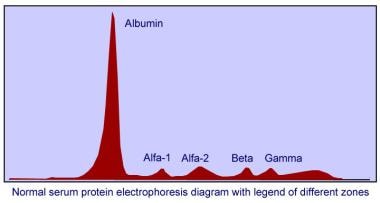Today, I reviewed emedicine.medscape.com‘s Serum Protein Electrophoresis.
All that follows is from the above resource.
Background
Description
Serum protein electrophoresis (SPEP) is an easy, inexpensive method of separating proteins based on their net charge, size, and shape. The 2 major types of protein present in the serum are albumin and the globulin proteins. Albumin is the major protein component of serum and represents the largest peak that lies closest to the positive electrode. [1] Globulins make up a much smaller fraction of the total serum protein but represent the primary focus of interpretation of serum protein electrophoresis. Five globulin categories are represented: alpha-1, alpha-2, beta-1, beta-2, and gamma, with the gamma fraction being closest to the negative electrode (see the image below).
Indications/Applications
Serum protein electrophoresis is generally considered in any patient with an elevated total protein, especially those with elevated globulin level relative to albumin, or any signs and symptoms suggestive of an underlying plasma cell disorder such as multiple myeloma, Waldenstrom’s macroglobulinemia, or primary amyloidosis. [5] These include any of the following:
Unexplained anemia, back pain, bone pain, fatigue
Unexplained pathologic fracture or lytic lesions
Unexplained peripheral neuropathy
Hypercalcemia secondary to possible malignancy
Hypergammaglobulinemia
Rouleaux formation noted on peripheral blood smear
Renal insufficiency with bland urine sediment
Unexplained proteinuria
Bence Jones proteinuria [11]
Recurrent infections
A study by Piza et al indicated that SPEP may be useful in children and adolescents as an early screen for antibody deficiency. In persons under age 18 years, electrophoretically determined serum gamma globulin fraction had an overall sensitivity and specificity of 100% and 87.8%, respectively, in the detection of IgG levels under the reference range. For calculated globulin (in which albumin levels are subtracted from total protein), the sensitivity and specificity were 93.2% and 81.8%, respectively. [12]





